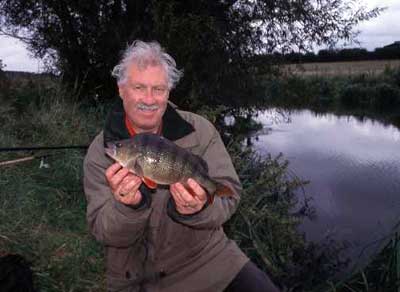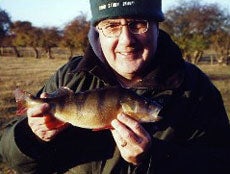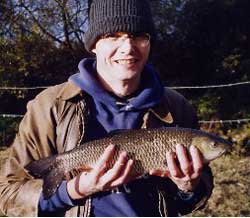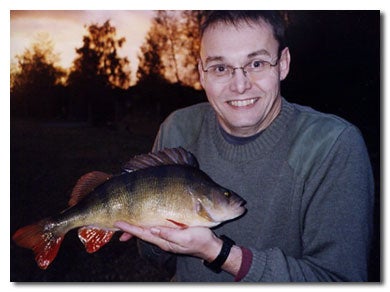| MARK WINTLE |
| Mark Wintle, an angler for thirty-five years, is on a quest to discover and bring to you the magic of fishing. Previously heavily involved with match fishing he now fishes for the sheer fun of it. With an open and enquiring mind, each week Mark will bring to you articles on fishing different rivers, different methods and what makes rivers, and occasionally stillwaters, tick. Add to this a mixed bag of articles on catching big fish, tackle design, angling politics and a few surprises. Are you stuck in a rut fishing the same swim every week? Do you dare to try something different and see a whole new world of angling open up? Yes? Then read Mark Wintle’s regular weekly column. |
PERCH ON THE UPPER OUSE
Back in the summer, Dave Slater promised to take me fishing on the Upper Ouse as an opportunity for me to try a different river. The Ouse is one of those rivers that has fired my imagination. Made famous by the famous, including J W Martin, Dick Walker, the Taylor brothers, and in more recent times, anglers like John Wilson and Tony Miles, it has long offered tough but exceptional fishing for a number of species including chub, perch and barbel. Dave managed to fish this club stretch of the Ouse above Bedford three times this season before our trip and caught some tremendous perch, culminating in a new personal best of 4-1, as well as some big chub to over five pounds. Because of holidays and other commitments, this trip took some organising.
I was concerned about the lack of rain but Dave reckoned that we should be all right. For bait, Dave needed to order lobworms in advance from British Worm Breeders so that once we had a date in mind we were stuck with it. During the days leading up to our trip, just two weeks after Dave had caught his big perch, the weather turned distinctly chilly for late October, with biting Northerly winds and hard frosts every night. Tackle requirements Gritting Lorries in October?
Dave suggested that we start with two particular swims that had previously been reliable. The field behind me was crisp with frost as I tackled up the float rod, cocking the float with 3AAA. I began to fish by searching the swim close to the reeds and weedbeds with a single lobworm, dragging bottom. A ray of hope.. then nothing As the sun rose above the horizon and the north wind freshened it became clear that we were in for a very hard day. The bites that Dave had had earlier quickly dried up. I hadn’t had a bite, and could see the bottom right across the swim. Dave suggested that I try two other swims further downstream. By ten o’clock, it appeared we were in trouble. The river was like tap water, very low and seemingly devoid of fish. One side effect of very cold weather on clay vale rivers is that the dropping water temperature causes the clay silt particles to become coated in lime and drop out of suspension. We decided to take a wander up and down the river to see if we could spot any fish. Dave pointed out big chub swims, yet the only fish that we saw were a few small roach in a couple of swims. No sign of perch at all. Surely, they must be in hiding. At least my blood was circulating again. We returned to our swims. Above where I had started, I spotted a small shoal of dace. Quickly retackling my float rod with 2lb line, a 20 hook and a tiny stick float, I knocked out a dozen tiny roach, dace and chublets. It was astonishing that the fish were there yet virtually invisible. The big perch are located at last
A chub at last A succession of quick knocks developed into a take by a ….tiny jack pike. Despite getting several more takes, I missed the lot. With two hours to dusk, I went to see how Dave was getting on. He could see the fish but nothing was much interested. I asked him if he’d mind if I tried an experiment of fishing above him with my stick float gear for ten minutes before we moved into our swims for dusk. I had just half a pint of maggots but I reckoned that ten minutes of heavy feeding and trotting double maggot would wipe the smile off the face of one of those chub. Could an old match angler do the business? Nine minutes. That’s what it took to get a bite on fine tackle from one of those chub. The final minute was spent playing a lively chub in fifteen inches of water and snags. Digging him out of the rushes with the landing net, I heaved him ashore. Not a monster at 4-1, but big enough to save face and my first Ouse chub. Perch action at last
At first, it was too bright but as five o’clock approached I got my first perch bite as a series of plucks followed by a fast pull. I struck and all hell let loose. Keeping firm control of the perch, I kept it out of the cabbages until Dave arrived with the net. It wasn’t the big one but at 2-14-4, it was my second best ever, a splendid hump-backed Ouse perch. After a quick photo, I got back in there. Five minutes later, I watched with increasing alarm as a jack pike approached my bait, then breathed a sigh of relief as it turned away, not realising that the quiver tip was pulling over. I struck. It was the jack. Once I’d landed him and put him back two swims downstream. I retied on the hook that he’d bitten off and recast. There were still perch moving about down there though the light was fading fast. Another good bite and I was into another big perch. This one wasn’t as deep as the first but it was slightly longer. It weighed 2-12. After that, I missed one more good bite. Had I blown my chance of the big one? Dave, meanwhile, apart from landing my fish, had missed a couple of bites, and then hooked and lost a perch, probably around a pound and a half. As darkness set in, it was time to hit the road after a long, tiring, tricky and challenging day. Conclusions I’d like to thank Dave for his skill, patience and hard work that made this trip a success despite the conditions. We both learnt a tremendous amount, and I hope you will too. Big perch can be caught to order but location is essential. This was my second ever trip on the Ouse. From what I’ve seen and read about the river, there are many stretches on the upper and middle Ouse offering fishing that is both challenging and exciting, and for a number of species. I hope to fish the Ouse again in the future. Next week: ‘Roach on Punch’ |

















